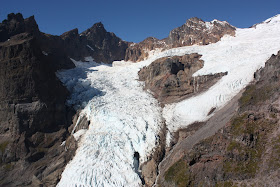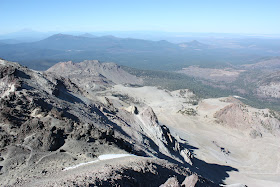 |
| Mount Baker from the Railroad Grade |
10.5 miles round trip, 3000 feet elevation gain
Difficulty: Moderate-StrenuousAccess: Gravel road easily handled by 2WD; Northwest Forest Pass required. Hiking season is July through September; bridge across creek is removed late in season
"Railroad Grade" doesn't sound like a promising hike name, but it actually refers to an absolutely fantastic hike up the moraine of the Easton Glacier to the high slopes of Washington State's Mt. Baker. This hike leads to up-close views of two massive glaciers and brings hikers up to the one of the climbers' camps for climbing Mt. Baker. On a clear day, there are views of peaks that are over a hundred miles away. Check trip reports from the Washington Trails Association for the latest conditions.
The hike is nearly three hours from Seattle, making it a bit of a long trip- however, the scenery along the hike more than justifies the effort needed to reach the trailhead. I hiked this trail with a friend at the University of Washington- we left Seattle fairly early in the morning, heading north on I-5 until we reached Burlington (over an hour) and then following Washington Highway 20 east through Sedro Woolley to Concrete; at Concrete, we turned left onto Burpee Hill Road and followed it until it joined Baker Lake Road; there we turned right and followed Baker Lake Road north, where we caught our only views of Mt. Shuksan that day. We turned left at the junction with NF-12, following the gravel road for a few minutes until we reached a junction with NF-13; here we took the right fork and followed NF-13 to its end at the Park Butte/Scott Paul Trailhead in the Mount Baker National Recreation Area.
We started down the the trail that left from the south side of the parking lot and headed towards Park Butte under clear September skies. The trail crossed a stream by bridge before crossing through a sparse forest in the flat bottom of the valley with minimal elevation gain. Occasional views of Mt. Baker popped out from the right side of the trail. As the trail approached a rocky crag on the western end of the valley, it turned north and began to gain elevation at a more noticeable and steady incline. Parts of this trail were very rocky and somewhat unpleasant; the rockiest section required crossing the creek that flowed down from the Easton Glacier. The creek was bridged at its most difficult crossings. Looking north from the bridge, we had our first clear view of Mt. Baker.
After crossing the creek, the trail reentered the forest and soon began a more aggressive climb, switchbacking its way up the western wall of the valley. After a substantial number of switchbacks and 2 miles of hiking, the trail came to a junction with the Scott Paul Trail. Here, you should avoid making the mistake my friend and I made of taking the right fork and heading onto the Scott Paul Trail; instead, you should stay left on the Park Butte Trail. The switchbacks ended after the junction; the trail straightened out and soon reached the junction with the Railroad Grade about 2.2 miles from the trailhead at the bottom of a large meadow.
My friend and I accidentally ended up on the Scott Paul Trail; not wanting to admit our mistake and backtrack, we decided to scramble up the lateral moraine of the Easton Glacier and bushwhack our way along the ridgeline back to the Railroad Grade trail. This was an extremely poor decision. Don't do it.
From the junction of the Park Butte Trail with the Railroad Grade Trail, take the right fork and head uphill into the wide meadows. For the next half mile or so, Mt. Baker fills the front of your vision as you ascend through the meadows and past perfect campsites to the base of the Railroad Grade, which is the long, narrow lateral moraine of the Easton Glacier.
 |
| The start of the Railroad Grade |
 |
| Glacier, White Chuck, and Sloan from the Railroad Grade |
 |
| Park Butte, Twin Sisters |
 |
| The peaks of the Cascades from the Railroad Grade |
 |
| Mt. Baker and the Easton Glacier |
We decided to get a closer view of the Easton Glacier and followed a footpath to the right of the camp that led past a small meltwater tarn to the edge of the moraine above the glacier. Being a little too adventurous and a dash reckless, we wanted to try to make it down to the side of the glacier. We picked a part of the moraine where the slope of the descent seemed fairly reasonable and began walking down. We soon realized that this was an extraordinarily bad idea- the moraine was less solid ground and more liquid ground. A few steps down on the moraine, a small portion of dirt beneath our feet suddenly collapsed and flowed downhill towards the glacier- a miniature mudslide. Afraid of setting off any more such slides, we retreated and had our on more solid ground overlooking the glacier and its magnificent crevasses.
 |
| Easton Glacier |
From the climbers' camp, we followed a climbers' path up a tiny gully on the west (left) side of the basin. This trail climbed through loose rock for about two hundred feet of elevation gain before reaching a saddle of sorts to the left of the trail. We left the path here, heading into the saddle and soon passing by a pair of aqua-colored meltwater ponds.
 |
| Meltwater pond, Twin Sisters |
If the Easton Glacier was notable for its size, then the Deming Glacier was notable for its drama. Though smaller than the Easton Glacier, the Deming Glacier was perhaps even more spectacular. The glacier flowed down the southwest slope of the cone of Mount Baker before making a great bend at the foot of Colfax Peak, then plunge into a precipitous icefall before reaching the bottom of its great self-carved canyon. Waterfalls emanated from within the glacier, pouring glacial meltwater that had coursed through the Deming's moulins down volcanic cliffs many hundreds of feet tall.
 |
| Deming Glacier flowing beneath the Black Buttes |
This hike is highly recommended, whether you're a Washington state resident or just visiting: if you like glaciers, you can't not like the Railroad Grade. The Deming Glacier off-trail is only recommended for hikers who have prior experience with off-trail navigation; climbing up the moraine of the Easton Glacier is recommended for no one.
 |
| Deming Glacier terminus, Twin Sisters |





































